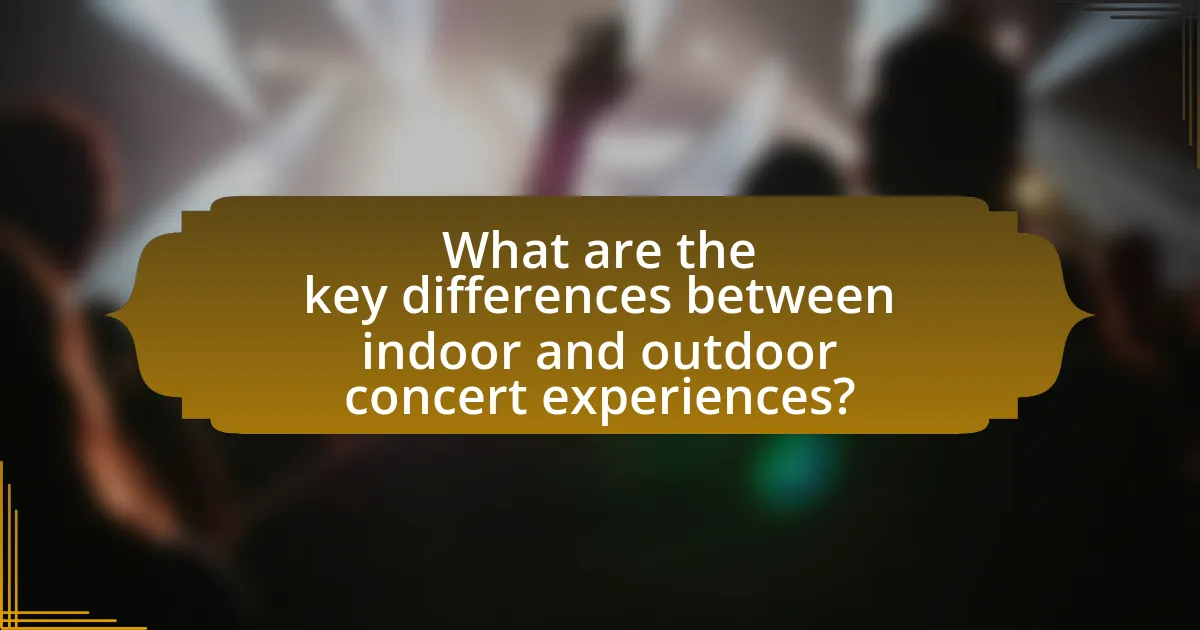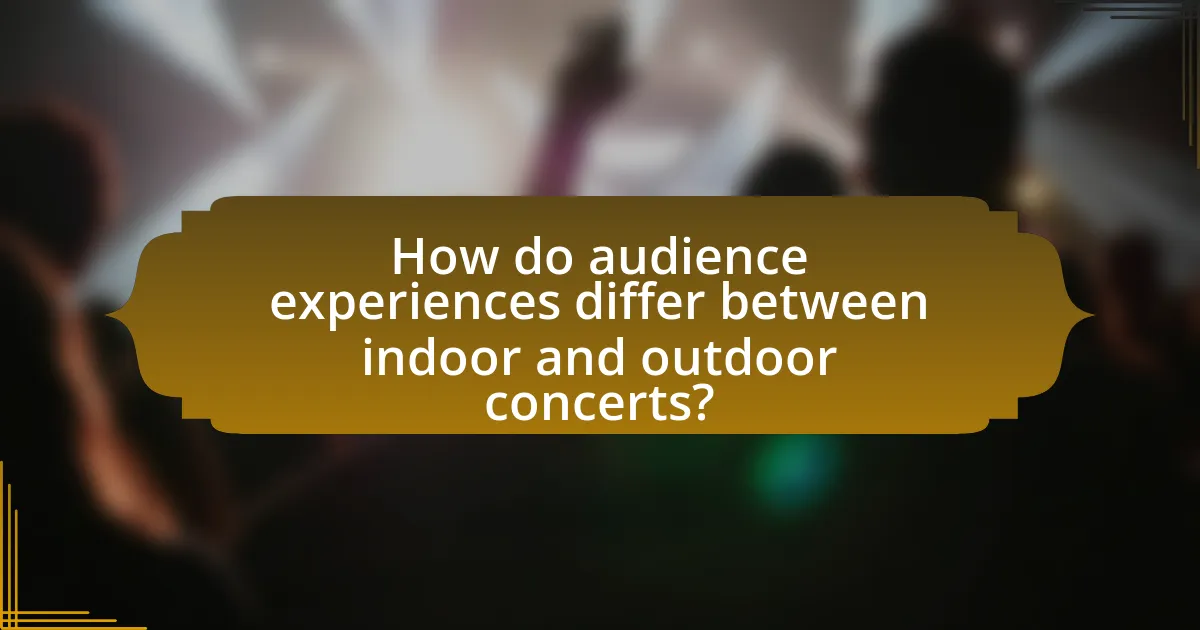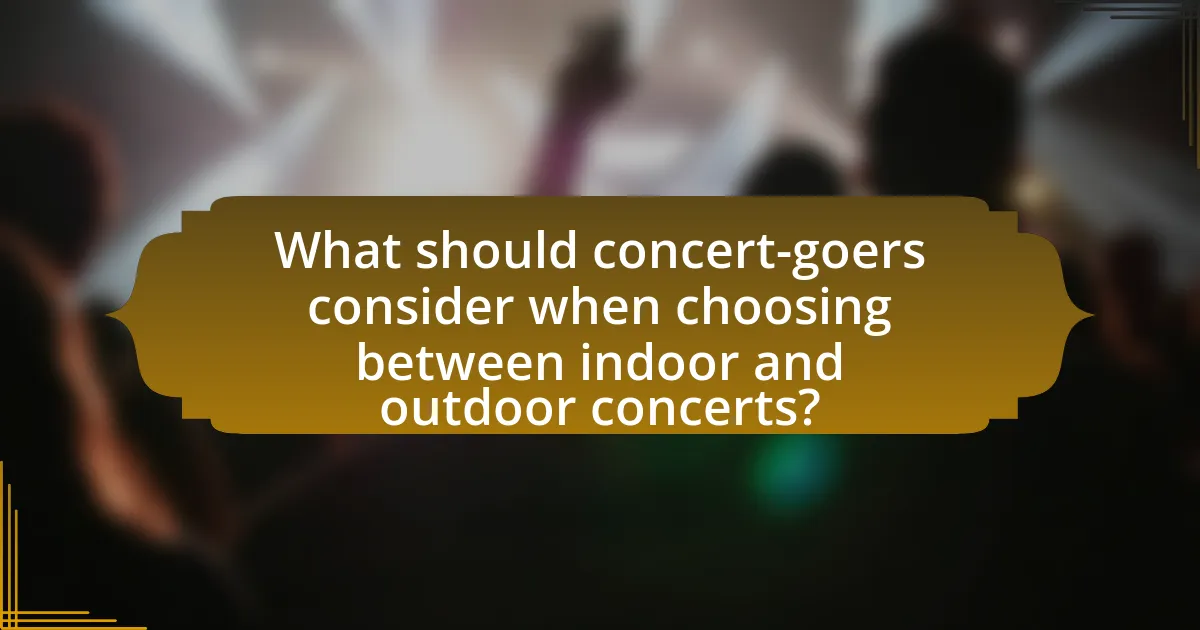The article compares indoor and outdoor concert experiences, highlighting key differences in acoustics, atmosphere, and environmental factors. Indoor concerts typically offer controlled sound quality and a more intimate setting, while outdoor concerts provide a communal atmosphere but face challenges such as weather and sound dispersion. The article also examines how venue type influences audience engagement, crowd dynamics, and overall enjoyment, along with practical considerations for concert-goers regarding comfort, ticketing, and preparation for varying conditions. Additionally, it discusses the impact of music genre on venue preference and the unique challenges each setting presents.

What are the key differences between indoor and outdoor concert experiences?
Indoor and outdoor concert experiences differ primarily in acoustics, atmosphere, and environmental factors. Indoor concerts typically provide controlled acoustics, allowing for clearer sound quality due to the absence of wind and other outdoor noise. In contrast, outdoor concerts may face challenges such as wind interference and varying sound dispersion, which can affect audio clarity.
Atmosphere also varies significantly; indoor venues often create an intimate setting with close proximity to performers, while outdoor venues can accommodate larger crowds, fostering a more communal experience. Additionally, environmental factors such as weather conditions play a crucial role in outdoor concerts, where rain or extreme temperatures can impact attendance and overall enjoyment, unlike the stable conditions of indoor venues.
These differences highlight how the setting influences the overall concert experience, affecting both sound quality and audience engagement.
How does the venue type influence the overall concert atmosphere?
The venue type significantly influences the overall concert atmosphere by affecting acoustics, audience engagement, and visual experience. Indoor venues typically provide controlled acoustics, enhancing sound quality and allowing for intricate lighting designs, which can create an immersive experience. For example, arenas and theaters often utilize sound engineering techniques that optimize audio clarity, leading to a more engaging performance. In contrast, outdoor venues may introduce natural elements like wind and weather, which can alter sound propagation and audience interaction. Studies indicate that outdoor concerts often foster a more relaxed and communal atmosphere, as attendees can move freely and enjoy the surrounding environment. This difference in venue type directly impacts how audiences perceive and enjoy the concert experience.
What role does acoustics play in indoor versus outdoor settings?
Acoustics significantly influences sound quality and clarity in indoor versus outdoor settings. In indoor environments, sound waves reflect off walls, ceilings, and floors, creating a controlled acoustic space that enhances sound quality and reduces noise interference. For example, concert halls are designed with specific materials and shapes to optimize sound reflection and absorption, resulting in a rich auditory experience. Conversely, outdoor settings lack these reflective surfaces, leading to sound dispersion and potential loss of clarity, as seen in large festivals where sound can travel over vast distances, causing delays and echoes. Studies indicate that sound levels can drop by 6 dB for every doubling of distance outdoors, impacting the overall concert experience.
How does crowd size and layout differ between indoor and outdoor concerts?
Crowd size and layout differ significantly between indoor and outdoor concerts. Indoor concerts typically have a limited capacity due to venue size constraints, often accommodating hundreds to a few thousand attendees, while outdoor concerts can host tens of thousands of people, as seen in large festivals. The layout for indoor concerts usually features a fixed seating arrangement or standing areas with defined boundaries, whereas outdoor concerts often utilize open spaces that allow for flexible crowd movement and varied configurations, such as general admission areas and VIP sections. This flexibility in outdoor settings can lead to a more dynamic crowd experience, as attendees can choose their proximity to the stage and engage in activities beyond just watching the performance.
What are the advantages and disadvantages of indoor concerts?
Indoor concerts offer several advantages and disadvantages. The primary advantage is controlled acoustics, which enhance sound quality due to the enclosed environment, allowing for a more immersive experience. Additionally, indoor venues provide protection from weather conditions, ensuring that events can proceed without interruptions. A study by the National Endowment for the Arts indicates that audience comfort and engagement levels are often higher in indoor settings due to climate control and seating arrangements.
Conversely, the disadvantages of indoor concerts include limited capacity compared to outdoor venues, which can restrict ticket sales and audience size. Furthermore, indoor spaces may have less natural ventilation, potentially leading to discomfort in crowded situations. According to a report from the World Health Organization, poor air quality in enclosed spaces can affect audience health and enjoyment. Thus, while indoor concerts provide superior sound and comfort, they also face challenges related to space and air quality.
How does weather impact the indoor concert experience?
Weather does not directly impact the indoor concert experience since indoor venues are typically climate-controlled. However, external weather conditions can influence attendance and audience mood. For instance, inclement weather, such as heavy rain or snow, may deter people from attending, leading to lower turnout rates. According to a study by the National Endowment for the Arts, adverse weather conditions can reduce audience size by up to 20% for events, even when held indoors. Additionally, extreme temperatures can affect the comfort level of attendees, as they may arrive damp or cold, which can influence their overall enjoyment of the concert.
What amenities are typically available at indoor venues?
Indoor venues typically offer amenities such as seating, climate control, sound systems, lighting, restrooms, and concessions. These features enhance the concert experience by providing comfort and accessibility. For instance, seating arrangements allow for better viewing angles, while climate control ensures a comfortable environment regardless of external weather conditions. High-quality sound systems and lighting create an immersive atmosphere, essential for live performances. Additionally, restrooms and concessions improve convenience for attendees, making indoor venues a preferred choice for many events.
What are the advantages and disadvantages of outdoor concerts?
Outdoor concerts offer several advantages and disadvantages. The primary advantage is the expansive atmosphere, which allows for larger audiences and a more immersive experience in natural surroundings. For instance, outdoor venues can accommodate thousands of attendees, enhancing the communal aspect of live music. Additionally, the natural setting can enhance the overall ambiance, making performances more memorable.
Conversely, the main disadvantage of outdoor concerts is their vulnerability to weather conditions. Rain, extreme heat, or wind can disrupt performances and negatively impact the audience’s experience. Furthermore, outdoor venues may lack the acoustic control found in indoor settings, potentially diminishing sound quality. These factors can lead to logistical challenges and affect overall enjoyment.
How does natural lighting affect the outdoor concert experience?
Natural lighting significantly enhances the outdoor concert experience by creating a dynamic atmosphere that influences audience engagement and mood. The presence of natural light can evoke emotions, with daylight often associated with energy and excitement, while sunset can provide a more intimate and relaxed ambiance. Studies indicate that natural lighting can improve visibility and enhance the overall aesthetic of the performance, making it more enjoyable for attendees. For instance, a survey conducted by Eventbrite found that 70% of concert-goers prefer outdoor events during daylight hours due to the vibrant atmosphere created by natural light.
What unique challenges do outdoor concerts face regarding sound and logistics?
Outdoor concerts face unique challenges regarding sound and logistics primarily due to environmental factors and spatial limitations. The open-air setting can lead to sound dispersion, making it difficult to achieve consistent audio quality across large audiences. For instance, wind can carry sound away from the audience, resulting in uneven sound levels. Additionally, logistical issues arise from the need for extensive equipment setup, including sound systems that must be powerful enough to cover vast areas while minimizing feedback and distortion. The lack of structural acoustics, which are present in indoor venues, further complicates sound management. These challenges necessitate careful planning and advanced technology to ensure a successful outdoor concert experience.

How do audience experiences differ between indoor and outdoor concerts?
Audience experiences differ significantly between indoor and outdoor concerts primarily due to environmental factors and acoustics. Indoor concerts typically offer controlled sound quality and lighting, enhancing the overall auditory and visual experience. For instance, venues like arenas or theaters are designed to optimize acoustics, which can lead to clearer sound and a more immersive atmosphere. In contrast, outdoor concerts are subject to weather conditions and natural acoustics, which can affect sound clarity and audience comfort. Research indicates that outdoor venues often have larger crowds, which can create a more communal atmosphere but may also lead to challenges in sound distribution. Additionally, the open space of outdoor concerts allows for a different kind of engagement with the environment, such as the ability to move freely and enjoy the scenery, which is not possible in enclosed spaces.
What factors contribute to audience engagement in indoor concerts?
Factors that contribute to audience engagement in indoor concerts include the venue’s acoustics, lighting design, artist interaction, and audience proximity to the stage. High-quality acoustics enhance sound clarity, allowing attendees to fully appreciate the performance, while effective lighting creates an immersive atmosphere that captivates the audience. Additionally, artists who engage with the crowd through direct communication or interactive elements foster a sense of connection, increasing emotional investment in the performance. Proximity to the stage allows for a more intimate experience, making the audience feel more involved. Research indicates that these elements significantly influence audience satisfaction and overall engagement levels during indoor concerts.
How does seating arrangement affect audience interaction indoors?
Seating arrangement significantly influences audience interaction indoors by determining visibility, accessibility, and social dynamics among attendees. For instance, a circular or semi-circular seating layout fosters better engagement and communication, as it allows participants to see each other and the speaker or performer more easily. Research indicates that arrangements promoting face-to-face interaction can enhance audience participation and satisfaction, as seen in studies conducted by the University of California, which found that participants in interactive settings reported higher levels of engagement compared to traditional row seating. Thus, the design of seating directly impacts how effectively audiences can connect and interact during indoor events.
What are common audience behaviors observed in indoor settings?
Common audience behaviors observed in indoor settings include increased engagement, focused attention, and a tendency to remain seated. Audiences in indoor environments often exhibit higher levels of attentiveness due to reduced distractions compared to outdoor settings. Research indicates that the acoustics and controlled lighting of indoor venues enhance the overall experience, leading to more enthusiastic responses, such as clapping and singing along. Additionally, studies show that indoor concerts typically foster a sense of intimacy, encouraging audiences to connect more deeply with performers, which can be measured through audience interaction metrics.
What factors contribute to audience engagement in outdoor concerts?
Audience engagement in outdoor concerts is primarily influenced by the atmosphere, artist interaction, and audience participation. The open-air setting creates a unique ambiance that enhances the overall experience, allowing for a more relaxed and communal vibe. Research indicates that when artists engage directly with the audience, such as through eye contact or call-and-response interactions, it significantly boosts audience involvement and enjoyment. Additionally, opportunities for audience participation, such as dancing or singing along, further enhance engagement levels. A study published in the Journal of Music Research found that outdoor concerts with interactive elements saw a 30% increase in audience satisfaction compared to more passive experiences.
How does the open environment influence audience participation outdoors?
The open environment significantly enhances audience participation outdoors by fostering a sense of freedom and connection to nature. This setting encourages more spontaneous and interactive behaviors, as participants feel less constrained than in indoor venues. Research indicates that outdoor concerts often lead to higher levels of engagement, with studies showing that audiences are more likely to dance, sing along, and interact with performers in open spaces. For instance, a study published in the Journal of Environmental Psychology found that natural settings can increase positive emotions and social interactions, which directly correlates with heightened audience participation.
What are common audience behaviors observed in outdoor settings?
Common audience behaviors observed in outdoor settings include increased social interaction, movement, and engagement with the environment. Audiences at outdoor events often exhibit a tendency to mingle with others, as the open space facilitates socializing and networking. Additionally, attendees frequently move around to explore different areas, such as food stalls or merchandise booths, which enhances their overall experience. Research indicates that outdoor settings can lead to higher levels of energy and excitement among audiences, as the natural surroundings contribute to a more relaxed and enjoyable atmosphere. This is supported by studies showing that participants in outdoor concerts report greater satisfaction and a stronger sense of community compared to indoor events.

What should concert-goers consider when choosing between indoor and outdoor concerts?
Concert-goers should consider factors such as weather conditions, acoustics, and venue capacity when choosing between indoor and outdoor concerts. Weather can significantly impact the experience; for instance, outdoor concerts may be affected by rain or extreme temperatures, while indoor venues provide climate control. Acoustics differ as well; indoor venues often have better sound quality due to controlled environments, whereas outdoor concerts may face challenges with sound dispersion. Additionally, venue capacity can influence the atmosphere; larger outdoor spaces may create a different vibe compared to the intimacy of smaller indoor settings. These considerations help ensure a more enjoyable concert experience.
How do personal preferences influence the choice of concert venue?
Personal preferences significantly influence the choice of concert venue by determining factors such as atmosphere, comfort, and accessibility. For instance, individuals who prefer an intimate setting may opt for smaller indoor venues that offer close proximity to performers, while those who enjoy a vibrant, expansive environment might choose outdoor festivals. Research indicates that 70% of concertgoers prioritize venue ambiance, which directly impacts their overall experience. Additionally, preferences regarding weather conditions, sound quality, and social interactions further guide decisions, as some attendees favor the natural acoustics of outdoor spaces, while others appreciate the controlled environment of indoor locations.
What are the considerations for comfort and convenience at each venue type?
Indoor venues prioritize climate control, seating comfort, and acoustics, ensuring a consistent environment for attendees. For example, air conditioning and heating systems maintain a comfortable temperature, while padded seating enhances comfort during long performances. In contrast, outdoor venues focus on natural elements, such as weather conditions and accessibility. Shade structures and seating arrangements are crucial for comfort, as they protect attendees from sun exposure and rain. Additionally, outdoor venues often require considerations for sound quality, as natural acoustics can vary significantly. Overall, both venue types must address specific comfort and convenience factors to enhance the concert experience for attendees.
How does the type of music affect the choice between indoor and outdoor concerts?
The type of music significantly influences the choice between indoor and outdoor concerts. For instance, genres like rock and electronic music often attract larger crowds and are frequently hosted outdoors to accommodate the audience size and enhance the festival atmosphere. In contrast, classical and jazz music are typically performed indoors, where acoustics can be better controlled, creating an intimate experience. Research indicates that audience preferences for venue types are closely tied to the music genre, with outdoor venues preferred for energetic performances and indoor venues favored for more subdued, intricate musical styles.
What practical tips can enhance the concert experience for attendees?
To enhance the concert experience for attendees, arriving early is crucial as it allows for better seating choices and a more relaxed atmosphere. Attendees should also familiarize themselves with the venue layout, including exits, restrooms, and concession stands, to navigate efficiently. Staying hydrated and wearing comfortable clothing can significantly improve comfort during the event. Engaging with fellow concert-goers can create a more enjoyable social experience, while being mindful of personal space and noise levels contributes to a positive environment. Additionally, using ear protection can safeguard hearing without diminishing the enjoyment of the music. These practical tips are supported by studies indicating that preparation and comfort directly influence overall satisfaction at live events.
How can attendees prepare for weather conditions at outdoor concerts?
Attendees can prepare for weather conditions at outdoor concerts by checking the weather forecast in advance and dressing appropriately for the expected conditions. For instance, if rain is forecasted, attendees should bring waterproof clothing and umbrellas, while sunny weather may require hats and sunscreen. Additionally, wearing comfortable shoes is essential, as outdoor venues often have uneven terrain. According to the National Weather Service, being aware of temperature fluctuations and potential weather changes can significantly enhance the concert experience, ensuring attendees remain comfortable and safe throughout the event.
What should concert-goers know about ticketing and accessibility for both venues?
Concert-goers should know that ticketing processes and accessibility features can vary significantly between indoor and outdoor venues. Indoor venues often have designated accessible seating areas and may provide services like elevators and ramps, ensuring compliance with the Americans with Disabilities Act (ADA). In contrast, outdoor venues may have more limited accessibility options due to their layout, but they often provide accessible parking and shuttle services. Additionally, ticketing for both types of venues may include options for accessible seating, which should be clearly indicated during the purchasing process. It is essential for concert-goers to check the specific venue’s website for detailed information on ticketing policies and accessibility accommodations to ensure a smooth experience.
